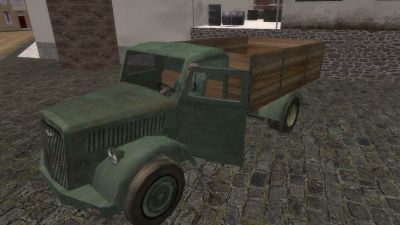Difference between revisions of "Opel Blitz"
(Created page with "=History= {| class="wikitable floatright" | colspan="2" style="text-align: center;" | 400px |- style="background:#666600; color:#fff;" | colspan...") |
Tag: Manual revert |
| (One intermediate revision by one other user not shown) | |
(No difference)
| |
Latest revision as of 07:32, 27 July 2023
History

| |
| Opel Blitz | |
| Specifications | |
| Type | 3-ton Truck |
| Maximum Speed | 80 km/h |
The 1920s was a decade of expansion for the American firm of General Motors (GM). In 1929, GM acquired the motor firm Adam Opel AG, based in Russelsheim, Germany, and with it, one of the most well regarded manufacturing plants in Europe.
In the early 1930s, Opel introduced a fast light truck it called the Opel Blitz (lightning) and in 1935 opened the best and most modern truck factory in the world in Brandenburg. Although light in weight, the Blitz design could carry a considerable payload. A proven six-cylinder engine from another GM company, Buick, provided the power.
The Blitz evolved over the decade. The payload increased in steps from the original 1.75 tonnes to 2.5 tonnes, and finally to the three tonnes that the S type could transport cross-country.
German authorities were leery of Opel and did not entirely trust its American management, but coveted the company’s reliable, tough, and easily maintained vehicles. To solve its dilemma, the German government took control of the Opel factory in 1940. GM would only regain control in November 1948.
By war’s end, Opel factories had churned out over 100,000 Blitz trucks alone for the German war effort. These took many different forms, such as general-purpose trucks, buses, radio trucks, ambulances, and even large limousines for high-ranking officers.
The Blitz proved far superior to any of its competitors. It could go where no other two-wheel drive vehicles could, it was the most reliable and toughest of all German trucks in its class, and, best of all, Opel’s excellent production facilities kept spares flowing that kept the Blitz going. The gasoline engines also provided an advantage – gasoline was easier to obtain than the diesel fuel required by other trucks. Studies carried out by German forces in regions such as North Africa and Russia gave the Blitz glowing reports while slighting vehicles such as the Mercedes and NSU.
The A type Blitz, a four-wheel-drive version, entered service in 1940 (over 25,000 built) and a half-track version entered production in 1942 as the Opel Maultier (mule). Approximately 4,000 Maultiers were built.
In the game, the Opel Blitz trucks tow light anti-tank and anti-aircraft guns, ferry troops around, and also act as a German mobile spawn point (MSP) creator.